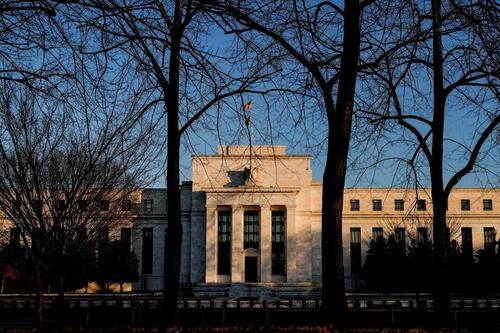The Fed Is Powerful… That’s The Problem
Authored by Matthew Blakely via the Foundation for Economic Education (FEE),
Whenever the Federal Reserve releases its meeting minutes, a crowd of analysts rush to dissect every comma and qualifier. But in a country that prides itself on free markets and capitalist dynamism, why do we hang on the every word of an exclusive club of central planners?
Markets shouldn’t have to interpret the tone of Jerome Powell’s press conferences or scrutinize the footnotes of bureaucratic transcripts.
But they do—because we’ve built an economy where interest rates, the price of credit, and the flow of capital are controlled not by supply and demand, but by a small committee of bankers and economists.
The problem isn’t just Powell.
The problem is that we’ve come to accept central planning at the heart of a supposedly free-market system.
What is an interest rate, if not a price? It’s simply the price of borrowing money. Every time the U.S. Treasury sells a bond, it must pay a price—an interest rate—to attract lenders. The same is true for corporations issuing debt, businesses taking out loans, or individuals financing homes and cars. Like any other price in a market economy, interest rates should respond to supply and demand.
When demand for borrowing rises, interest rates should increase to ration limited funds. When the supply of savings grows, rates should fall to reflect greater availability of capital. These aren’t exotic economic theories—they’re the same price signals that govern what we pay for groceries, smartphones, or pencils.
And yet, interest rates occupy a unique place in our economy—treated as too vital to be governed by market forces. Instead of allowing borrowers and lenders to determine rates naturally, we give this task to the Federal Reserve: a small group of economists with disproportionate influence over market movements through manipulating the supply and demand for U.S. Treasurys.
The Federal Reserve has wielded this rate-setting ability to dramatic effect over the decades—raising interest rates aggressively in response to the unchecked inflation of the 1970s, then slashing them to near zero for years following the 2008 financial crisis, and again during the COVID-19 pandemic. The central logic behind these actions is that cheap borrowing energizes economic activity because lower rates incentivize consumer spending and business investment. Indeed, many economists justify this authority as a necessity, but few highlight the significant drawbacks and long-term tradeoffs.
Nobel laureate Friedrich Hayek argued that prices are signals. Interest rates are arguably the most important prices in the economy. They guide entrepreneurs and investors in allocating capital by indicating scarcity, demand, and risk. When the Federal Reserve distorts interest rates, it clouds these signals. Businesses struggle to assess the true cost of capital, while savers earn little or nothing on their savings. Worse, artificially cheap credit can inflate bubbles in real estate, equities, or crypto assets, driven by both the low cost of borrowing and the belief that such assets will outperform traditional, interest-linked investments like Treasury bonds.
The underlying problem isn’t just that the Fed sets interest rates—it’s that it does so based on internal models and incentives, divorced from the knowledge of the millions of people who participate in the very markets the Fed affects. By setting interest rates, the Fed obscures and overrides the natural market forces that would normally inform investments and business decisions. This central planning of interest rates, no matter how sophisticated the formulas and calculations employed by the Fed, invariably leads to misallocations of capital in the economy, distorts the incentives of both businesses and consumers alike, and obscures the true sentiment of marketplace participants.
In a true free market, interest rates would be a natural occurrence emerging from the interaction of savers and borrowers—just as other prices in the economy are. If we trust markets to determine the prices of oil, steel, and semiconductors, why not money? The more we rely on a small group of exclusive Federal Reserve governors to fine-tune the economy from the top down, the more we endanger the dynamism and resilience that made the US economy the envy of the world.
Maybe the problem isn’t just who chairs the Fed. Maybe the problem is the Fed itself. Hayek taught us that prices are not mere numbers—they are carriers of knowledge and critical to functioning markets. Thomas Sowell echoes this in his critiques of central banking, arguing that when we replace the knowledge and discipline of the market with the guesswork of central planners, the results are rarely benign. We must stop mistaking power for wisdom—and start trusting the market again.
Tyler Durden Tue, 06/24/2025 – 18:25
Source: https://freedombunker.com/2025/06/24/the-fed-is-powerful-thats-the-problem/
Anyone can join.
Anyone can contribute.
Anyone can become informed about their world.
"United We Stand" Click Here To Create Your Personal Citizen Journalist Account Today, Be Sure To Invite Your Friends.
Before It’s News® is a community of individuals who report on what’s going on around them, from all around the world. Anyone can join. Anyone can contribute. Anyone can become informed about their world. "United We Stand" Click Here To Create Your Personal Citizen Journalist Account Today, Be Sure To Invite Your Friends.
LION'S MANE PRODUCT
Try Our Lion’s Mane WHOLE MIND Nootropic Blend 60 Capsules
Mushrooms are having a moment. One fabulous fungus in particular, lion’s mane, may help improve memory, depression and anxiety symptoms. They are also an excellent source of nutrients that show promise as a therapy for dementia, and other neurodegenerative diseases. If you’re living with anxiety or depression, you may be curious about all the therapy options out there — including the natural ones.Our Lion’s Mane WHOLE MIND Nootropic Blend has been formulated to utilize the potency of Lion’s mane but also include the benefits of four other Highly Beneficial Mushrooms. Synergistically, they work together to Build your health through improving cognitive function and immunity regardless of your age. Our Nootropic not only improves your Cognitive Function and Activates your Immune System, but it benefits growth of Essential Gut Flora, further enhancing your Vitality.
Our Formula includes: Lion’s Mane Mushrooms which Increase Brain Power through nerve growth, lessen anxiety, reduce depression, and improve concentration. Its an excellent adaptogen, promotes sleep and improves immunity. Shiitake Mushrooms which Fight cancer cells and infectious disease, boost the immune system, promotes brain function, and serves as a source of B vitamins. Maitake Mushrooms which regulate blood sugar levels of diabetics, reduce hypertension and boosts the immune system. Reishi Mushrooms which Fight inflammation, liver disease, fatigue, tumor growth and cancer. They Improve skin disorders and soothes digestive problems, stomach ulcers and leaky gut syndrome. Chaga Mushrooms which have anti-aging effects, boost immune function, improve stamina and athletic performance, even act as a natural aphrodisiac, fighting diabetes and improving liver function. Try Our Lion’s Mane WHOLE MIND Nootropic Blend 60 Capsules Today. Be 100% Satisfied or Receive a Full Money Back Guarantee. Order Yours Today by Following This Link.







